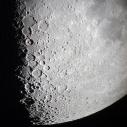The Thunder ChildScience Fiction and Fantasy |
| |

|
Non-Fiction Book Reviews by Ryan Brennan
Virgiliu Pop's Unreal Estate: The Men Who Sold The Moon chronicles the known history of the many attempts made to buy and sell our lunar neighbor.
Even in that remote time, but certainly more strongly as the decades slipped by, the Moon represented the last great unexplored region. For some, the thought of conquering the easily seen but distant land, and acquiring the vast tracts of acreage available there, inflamed the mind. And while some may have taken in gullible marks ready to part with their money for a stake on the lunar surface, as Pop demonstrates, pure profit was not generally the motive for men wanting to own the moon. And when I say "men" I use the word correctly, for there are no women mentioned in the many schemes to legally secure the Moon as personal property. A. Dean Lindsay is one of the earliest men to be associated with owning the Moon. In 1937 he registered a claim, witnessed before a Notary Public, and was dubbed "World's Richest Man." His claim, and his fame, caught on with the public and Lindsay, who also appeared in Ripley's Believe It Or Not because he owned a domesticated porcupine, was featured on radio and was spoofed in a popular comic strip of the day. The U.S. Department of the Interior has been approached so many times over the years regarding Moon ownership — over 200 times by 1965 — that a form letter was drafted. Throughout, the Department has maintained that to make a legitimate claim, the claimant must first inspect the land, file the claim, then meet a requirement of six months residency on said land. Obviously, no one, so far, has been able to meet this criteria.
Publicity is the most cited reason for individuals and groups offering Moon (and other celestial bodies) lots for sale. Publicity could not only raise the profile of an individual or organization but was also helpful in fundraising attempts. In 1952 one such group, Elves, Gnomes, and Little Men's Science Fiction, Chowder, and Marching Society, said to be inspired by Robert Heinlein's The Man Who Sold the Moon, found their claims covered internationally. They were counter-challenged by Alexander F. Victor, a Swedish motion picture pioneer who founded the Victor Animatograph Corporation, invented the electric washing machine, a 16mm camera, and safety film. That same year, the 10th World Science Fiction Convention gave attendees cards assigning them ownership of specific Moon craters. Arthur C. Clarke, Ray Bradbury and Philip Jose Farmer were all lucky recipients. Often, Moon ownership overlapped with or led to claims against other heavenly bodies. In 1956 the Japan Astronautical Society sold Mars plots. So famous was this event that the popular Japanese science fiction film The Mysterians had improvised dialogue about Earthlings selling real estate on the Moon and Mars without permission. Even later, the 1999 film Kasei no Waga Ya (Mars Sweet Home) incorporated the nationally known and remembered selling of Mars plots into its story. Some claims were made in a roundabout manner. Richard Garriott, through a Sotheby's auction, bought one of the abandoned Soviet Lunakhods left on the moon. His rationale was that if he had an actual property on the Moon it might establish some sort of squatter's rights and give him a legitimate claim to Moon property. Another Moon property aspirant, Jim Benson of SpaceDev planned to build a robot craft that would land on an asteroid. Using the camera eye to view the property could be a legal maneuver around the requirement to personally inspect the land. In 1998 the Native American organization The Western Federation Church and Tribe got in on the action. And three men from Yemen claimed they inherited the moon from their ancestors who lived there 3,000 years ago. For a bit of variety, Russ Wylie made it fun to buy Uranus. Deer Park, Texas, the home of the San Jacinto monument, acquired Venus by annexing all the vertical space between Earth and the planet. In St. Paul, Alberta, Canada a UFO landing pad was built in conjunction with the sale of Mars plots. In the 1950s, no doubt in connection with that decade's science fiction movie and TV craze, Nabisco, Post or Quaker Oats (depending on who you ask), offered one-inch square lots on the moon for cereal box tops. More recently, Nestle gave away meteorite dust on a series of 20 different collectible cards. Probably the most serious Moon entrepreneur was the aforementioned Dennis Hope. Hope founded the Lunar Embassy and, over several decades, used it as platform for education and space property reform. His sincerity led him to the U.N. and placed him at odds with governments he felt intruded on his rights. Also, Thomas P. Budnik was genuine in filing numerous mineral claims for fear that the U.S. would lose out and be left behind.
Unfortunately, poring over the many individuals and organizations who claim to own part or all of the Moon (there are, literally, millions worldwide), as well as all off-Earth space becomes a bit repetitious and monotonous. Whether it's the United Societies in Space, Lunar Republic Society, Galactic Government, Interplanetary Development Corporation, Lunar Fantasy Corporation, The Original Moon Owners of Surry Slope or legitimate groups like the Maryland Academy of Sciences, South Florida Science Museum, Newark High School Astronomy Club or Fiske Planetarium, there is little variation in their names or stories. The author does not attempt to explain humankind's fascination with the Moon or what it may have meant to us over the years. The explanation for why anyone would be interested in buying the Moon, or thinking that they could do so, is presented only at face value. The book is lacking in illustrations, too, providing only a few reproductions of ephemera from the ephemeris. However, despite these drawbacks, this book represents a one-stop shop for the topic, providing the reader with as much information as he or she could possibly need on the gullibity (for whatever, unexplored reasons) of mankind. Return to:
|
All text © 2006 The Thunder Child unless otherwise credited.
All illustrations retain original copyright.
Please contact us with any concerns as to correct attribution.
Any questions, comments or concerns contact The Thunder Child.









